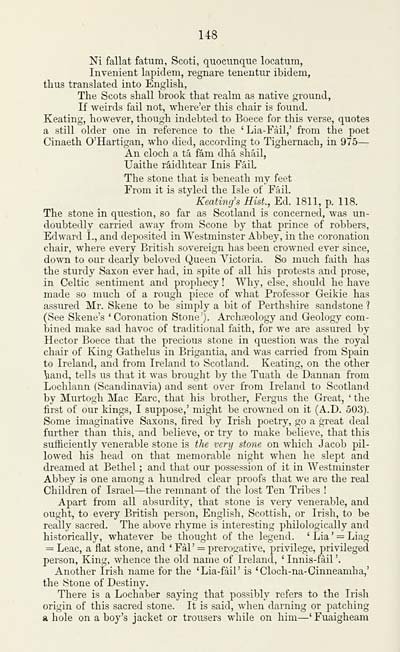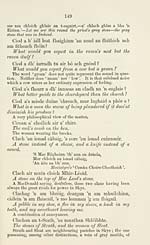Download files
Complete book:
Individual page:
Thumbnail gallery: Grid view | List view

148
Ni fallat fa turn, Scoti, quocunque locatura,
Invenient lapidem, regnare teueutur ibidem,
ttus translated into English,
The Scots shall brook that realm as native ground,
If weirds fail not, where'er this chair is found.
Keating, however, though indebted to Boece for this verse, quotes
a still older one in reference to the 'Lia-Fàil,' from the poet
Cinaeth O'Hartigan, who died, according to Tighernach, in 975 —
An cloch a ta fam dha shail,
Uaithe raidhtear Inis Fail
The stone that is beneath my feet
From it is styled the Isle of Fail.
Keatinr/s Hist., Ed. 1811, p. 118.
The stone in question, so far as Scotland is concerned, was un-
doubtedly carried away from Scone by that prince of robbers,
Edward I., and deposited in Westminster Abbey, in the coronation
chair, where every British sovereign has been crowned ever since,
down to our dearly beloved Queen Victoria. So much faith has
the sturdy Saxon ever had, in spite of all his protests and prose,
in Celtic sentiment and prophecy ! Why, else, should he have
made so much of a rough piece of what Professor Geikie has
assured Mr. Skene to be simply a bit of Perthshire sandstone ?
(See Skene's 'Coronation Stone'). Archaeology and Geology com-
bined make sad havoc of traditional faith, for we are assured by
Hector Boece that the precious stone in question was the royal
chair of King Gathelus in Brigantia, and was carried from Spain
to Ireland, and from Ireland to Scotland. Keating, on the other
\iand, tells us that it was brought by the Tuath de Dannan from
Lochlann (Scandinavia) and sent over from Ireland to Scotland
by Murtogh Mac Earc, that his brother, Fergus the Great, ' the
first of our kings, I suppose,' might be crowned on it (A.D. 503).
Some imaginative Saxons, fired by Irish poetry, go a great deal
further than this, and believe, or try to make believe, that this
sufficiently venerable stone is the very stone on which Jacob pil-
lowed his head on that memorable night when he slept and
dreamed at Bethel ; and that our possession of it in Westminster
Abbey is one among a hundred clear proofs that we are the real
Children of Israel— the remnant of the lost Ten Tribes !
Apart from all absurdity, that stone is very venerable, and
ought, to every British person, English, Scottish, or Irish, to be
really sacred. The above rhyme is interesting philologically and
historically, whatever be thought of the legend. ' Lia ' = Liag
= Leac, a flat stone, and ' Fàl' = prerogative, privilege, privileged
person. King, whence the old name of Ireland, ' Innis-fàil '.
Another Irish name for the 'Lia-fàil' Ls 'Cloch-na-Cinneamha,'
the Stone of Destiny.
There is a Lochaber saying that possibly refers to the Irish
origin of this sacred stone. It is said, when darning or patching
a hole on a boy's jacket or trousers while on him — ' Fuaigheam
Ni fallat fa turn, Scoti, quocunque locatura,
Invenient lapidem, regnare teueutur ibidem,
ttus translated into English,
The Scots shall brook that realm as native ground,
If weirds fail not, where'er this chair is found.
Keating, however, though indebted to Boece for this verse, quotes
a still older one in reference to the 'Lia-Fàil,' from the poet
Cinaeth O'Hartigan, who died, according to Tighernach, in 975 —
An cloch a ta fam dha shail,
Uaithe raidhtear Inis Fail
The stone that is beneath my feet
From it is styled the Isle of Fail.
Keatinr/s Hist., Ed. 1811, p. 118.
The stone in question, so far as Scotland is concerned, was un-
doubtedly carried away from Scone by that prince of robbers,
Edward I., and deposited in Westminster Abbey, in the coronation
chair, where every British sovereign has been crowned ever since,
down to our dearly beloved Queen Victoria. So much faith has
the sturdy Saxon ever had, in spite of all his protests and prose,
in Celtic sentiment and prophecy ! Why, else, should he have
made so much of a rough piece of what Professor Geikie has
assured Mr. Skene to be simply a bit of Perthshire sandstone ?
(See Skene's 'Coronation Stone'). Archaeology and Geology com-
bined make sad havoc of traditional faith, for we are assured by
Hector Boece that the precious stone in question was the royal
chair of King Gathelus in Brigantia, and was carried from Spain
to Ireland, and from Ireland to Scotland. Keating, on the other
\iand, tells us that it was brought by the Tuath de Dannan from
Lochlann (Scandinavia) and sent over from Ireland to Scotland
by Murtogh Mac Earc, that his brother, Fergus the Great, ' the
first of our kings, I suppose,' might be crowned on it (A.D. 503).
Some imaginative Saxons, fired by Irish poetry, go a great deal
further than this, and believe, or try to make believe, that this
sufficiently venerable stone is the very stone on which Jacob pil-
lowed his head on that memorable night when he slept and
dreamed at Bethel ; and that our possession of it in Westminster
Abbey is one among a hundred clear proofs that we are the real
Children of Israel— the remnant of the lost Ten Tribes !
Apart from all absurdity, that stone is very venerable, and
ought, to every British person, English, Scottish, or Irish, to be
really sacred. The above rhyme is interesting philologically and
historically, whatever be thought of the legend. ' Lia ' = Liag
= Leac, a flat stone, and ' Fàl' = prerogative, privilege, privileged
person. King, whence the old name of Ireland, ' Innis-fàil '.
Another Irish name for the 'Lia-fàil' Ls 'Cloch-na-Cinneamha,'
the Stone of Destiny.
There is a Lochaber saying that possibly refers to the Irish
origin of this sacred stone. It is said, when darning or patching
a hole on a boy's jacket or trousers while on him — ' Fuaigheam
Set display mode to: Large image | Transcription
Images and transcriptions on this page, including medium image downloads, may be used under the Creative Commons Attribution 4.0 International Licence unless otherwise stated. ![]()
| Early Gaelic Book Collections > Blair Collection > Collection of Gaelic proverbs and familiar phrases > (188) |
|---|
| Permanent URL | https://digital.nls.uk/76279358 |
|---|
| Description | A selection of books from a collection of more than 500 titles, mostly on religious and literary topics. Also includes some material dealing with other Celtic languages and societies. Collection created towards the end of the 19th century by Lady Evelyn Stewart Murray. |
|---|
| Description | Selected items from five 'Special and Named Printed Collections'. Includes books in Gaelic and other Celtic languages, works about the Gaels, their languages, literature, culture and history. |
|---|

